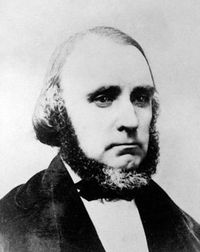 |
| William Clayton |
One of the most illuminating and elusive Mormon history resources, the diaries are not accessible except, apparently, to some working on the Joseph Smith Papers project (a few pages of the diaries were included in the latest Joseph Smith paper volume). As part of J. Stapley's review of of this volume, he tells the story of how the Clayton diaries became available to three researchers in the 70s, and how their transcripts have either come into print, or have influenced important works of history.
William Clayton was in Joseph Smith's inner circle and kept a detailed, personal journal of his experiences. Recording more than just the day-to-day events, he wrote about his feelings and challenges, as well as those of his associates. His record provides a frank look behind the scenes of Nauvoo, providing a view of how Joseph Smith's teachings were interpreted and practiced at that time.
Excerpts of REVIEW APPENDIX I: The Nauvoo Journal of William Clayton, by J. Stapley, BCC (half way down the page. BTW, Stapley's review of the Joseph Smith Papers, Journals, V. 2, also at this link is also worth reading).
--
... Clayton's journal is the most detailed account of the last two years of Smith's life. It is also the only contemporaneous account of many controversial aspects of that life: polygamy, the rift between Emma and Joseph over the topic, the temple quorum, the Council of Fifty, etc. ...
In the late 1970s the First Presidency granted access to several documents in their holding. Three scholars received access to the Nauvoo era Clayton journals, namely James B. Allen, Andrew F. Ehat, and D. Michael Quinn. They each prepared typescripts of varying quality. ...
Ehat collaborated with Lyndon Cook on several projects, notably The Words of Joseph Smith. ... A copy [of the transcript of the Clayton diaries] eventually made it to the Tanners who published it. ...
George Smith later edited the Ehat transcript and included it with publicly available Clayton journals and a transcript of a purloined copy of the Heber C. Kimball temple journal kept by Clayton in the widely cited, An Intimate Chronicle. Allen reviewed this volume and concluded that content selection of the Nauvoo journals was highly skewed, likely reflecting Ehat's research interests.
Allen's complete typescript has not been made publicly available beyond employees of the LDS Church History Library. However, in 2002 Allen published a revised and retitled version of his Clayton biography, which included an appendix of Clayton diary excerpts used as source material for the "Manuscript History," which comes to most of us as the History of the Church. This appendix remains the only published transcripts of several important portions of the diary. ...
Quinn eventually donated his research papers to the Beinecke Rare Book and Manuscript Library at Yale University, his alma mater, and his Clayton typescript is open to researchers. An unidentified party accessed this material and released two small printings (50 and 100 volumes respectively) of Clayton's Nauvoo diary. This volume apparently includes thirty percent more text than the Ehat transcript.
It is my understanding that the distribution of the Clayton diary was viewed by many within the Church hierarchy to be exploitative and a betrayal of trust. Since their release and until the JSP, no scholars have had access to the documents....
--
Read the full review here